The Stamford Historical Society Presents
Pride and Patriotism: Stamford’s Role in World War II
Online Edition
The Interviews
Nathan Norkin
Nathan Norkin was drafted in 1942 and joined the 922nd Engineering Aviation Regiment. His assignment in Europe was to head a reconnaissance group that searched for level fields where airfields could be constructed. He also helped scout out already existing airfields that could be repaired and used to supply Allied troops.
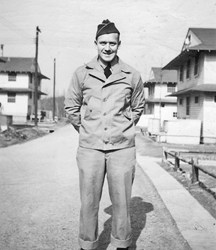 I was working as a cost accountant for a transportation company in Hartford, Connecticut when the war broke out. I had gotten my degree at Connecticut State College in 1939 and had started working in 1940.
I was working as a cost accountant for a transportation company in Hartford, Connecticut when the war broke out. I had gotten my degree at Connecticut State College in 1939 and had started working in 1940.
I first heard of Pearl Harbor at a football game, a New York Giants game…as a single man I wanted to enlist. I tried to enlist in the Army Air Corps, but at age 26, I was told I was too old to be a flyer…I heard the Navy was offering commissions V7 for college graduates, but you had to be native born citizen…I was not…I came at age 5 from Latvia. I was drafted in 1942 in January.
I was sent to Fort Belvoir, Virginia, Engineering School, I got basic training and was shipped out to a topographic mapping outfit. We mapped the coast of North Carolina for the US Geological Survey…we were a small group, stationed in North Carolina. I was buck private…I went to dance in North Carolina and found a nice young woman, I was having fun, then a young man with a stripe on his arm took her away…I thought, why? He had a gold bar on his shoulder...I decided I needed one of those to attract the ladies, and I applied the next day for Officer Candidate School. I spent three months…horrible months but I got a commission. The idea of OCS was to break you, they had attacked officers that tried to make you to leave, they were constantly nasty, and there were tests of all kinds, of the 50 that entered eight made it.
I was scheduled for a unit that formed in Washington State. I got there and saw of the unit the only ones there were a Commanding and an Executive Officer. There were no troops in the Army regiment. What am I doing here?? – I thought. I got news that the 922nd Engineering Aviation Regiment was getting ready to go overseas…I went to the Commanding Officer, a Colonel Parks…and asked if he could use another officer. “Sure” he said and I was made Assistant S4 and joined the regiment. S is supply, S1 personnel, S2 intelligence, S3 operation, S4 supply. In the regimental area in the army it’s G-1-4.
I was shipped overseas. I got on a train at Geiger Field, Washington and went to New York City. I embarked on the Queen Elizabeth, which was originally scheduled for 2000 people: on board there were 45,000 troops. I had officers’ accommodations, seven triple-decker beds, 21 men in a room. There were men on deck, etc. We got to Gairloch, Scotland. The ship had traveled at 30 knots, too fast for U-boats, and it changed course 90 degrees every seven minutes…zigzagging. We were all by ourselves, not in convoy.
We got to Scotland, then took a train to Birch England, 50 km north of London…We built an airfield for the British ‘42 to ‘43. Then we were alerted to go on the invasion force. We went from Birch to southern England, then on an LST (Landing Ship Tank) with equipment. We landed on D-Day +4 on Omaha Beach, Normandy. From Normandy we worked all the way across France, Belgium, and Germany and our last reconnaissance was at the Elbe River with Russians on the other side.
In England we were 10 months building Birch Airfield…we took over the construct from the Brits.
We knew nothing of the invasion before move to coast…
Omaha Beach was quiet at landing, we spent day 1 off the beach…2 miles inland…we were being shelled, not badly though, Germans were regrouping further east, we did not see any Germans. I had a reconnaissance group that consisted of me, 10 men, a jeep and a halftrack. Our duty was reconnaissance. I got orders from the Commanding Officer. We looked over the areas, went by maps – at a scale of 1/10,000, ordinary maps were 1/50,000. Our job was to locate strips where we could build airfields. It had to be 5000 ft long and relatively level. In Normandy it was not a level country, there were hedgerows, etc. We went about looking for fields, built several…the 922nd was Regimental HQ – we had three battalions – the workhorse of the group, we laid out plans, they did the job of actually building the airfield.
We were not running into enemy troops, we were fired at, shelled, but we never saw enemy troops, my jeep had a 30 caliber machine gun and the halftrack had a 50 caliber machine gun, we were not a fighting force. I had a 45 caliber pistol but I couldn’t hit the side of a barn with pistol . At Normandy I got an M16 rifle, off the beach, I carried that.
The beach was cleaned up by D-Day +4, no bodies…they had made a pier, they brought the pier from England, massive concrete blocks and put them side by side to create a pier so ships could unload. 50 years later it was still there.
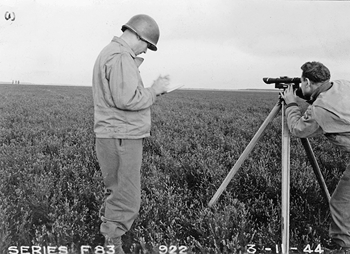 Building an airstrip took a couple of days to do. After we got into the France we would try to find and rehabilitate French airfields...
Building an airstrip took a couple of days to do. After we got into the France we would try to find and rehabilitate French airfields...
My first airfield was Orly…we had two recon parties, mine and Lieutenant Marzal’s…he went to Le Bourget. We were shelled at Orly…A little plane landed – the Commanding Officer Colonel Little was on it, I told him to get out because the airfield was not safe, so he took off and went to Le Bourget, there they got on a Weapons Carrier, bigger than jeep, he and the Executive Officer got on the airstrip and were machine gunned. They were both killed. The driver escaped. Lieutenant Marzal had told him to get off field too, but the Colonel decided to see for himself and was killed.
We were not responsible for securing fields...after I returned with information on a field, it would be secured, and repairs to be done would be carried out by the battalions. The battalion would come and repair the fields for C47 transport planes bring supplies in. The battalion was responsible for the safety of it. The 922nd Regimental HQ had no responsibility after the battalion was brought in…we were not combat engineers, but Air Force engineers.
All through France we went to many places and checked them out for fields, some were not usable. I came across one where the Germans had planted 500 lb bombs all across the main runway. They were tied together with electrical cords, undetonated. I went into a jeep and cut the wires off the bombs… We had to repair the runway.
One time Marzal and I found an airstrip or area of more than 5000 ft. level feet and we laid out the center of the runway with sod and all the parking areas all in one day…C47s came in eight or nine hours later. It was that quick.
We were away from HQ three to five days at a time. We were self-sufficient. We were in contact with HQ by radio…whenever a mission was complete we would go back to HQ and get a new mission. We had several different HQs as we moved…we moved with the troops and ended up on the Elbe River.
We had a motor pool officer, Lt. Patton, in charge of motor pool. We were out on mission when we ran out of gas. I didn’t know what to do… I had to try to find gas. Along the road came a gas convoy…what luck…I stopped the convoy...I asked for gas. The man in charge said, “Lieutenant. I can’t give you any gas. I’ve signed for it, it is for a gas depot.”…I said to myself Patton is going to be mad at this! He said, “Are you part of Patton’s outfit?”…I said, “Yes Sir.” and he told me to take all the gas I needed… He thought I was talking about General Patton…we went on our way.
There was no such thing as a front, never knew exactly where the enemy was… We would think maybe it was clear, maybe not, if we were fired on we backed off. Once we went down a road to go to an airfield in Germany and we didn’t know what was going on…we had a pee call…everyone went to pee…a jeep came rushing up… “Where are you going?” I was asked. “Oh, we are going to airfield down the road.” ”That airfield’s not taken yet”, I was told by the officer. I am one of leading group of the 3rd army division sent to take that airfield…To think we were leading the 3rd army division…the airfield ended up clear. That was the one time I led a division….
We never saw the enemy, not live anyway…dead yes….
Late in the war some Germans wanted to surrender to us…I was in no position to take them so I sent them on their way…they were disarmed. We never came across armed Germans. Closest to combat was being shot at and shelled. The bullets cracked when they passed by your ear…air rushes in, creates vacuum…
I did run across a Bounding Betty….an anti personal mine…German…They would bury a canister in the ground and in the canister was a shell. Around the shell they put trip wires…the idea was a person trips the wire and the booster boosts the shell eye high and it explodes around you. We ran across several but I never tripped one off.
I didn’t loose any guys during the war…one jeep was blown up by a land mine but the jeep was sandbagged – the bottom of the jeep was covered with sandbags.. When we found level areas we would ride the jeep over the area for a mile, 5000 feet. That was an airstrip’s size. One jeep with Lt. Marzal was blown up…but there was no real injury…a sandbag jeep takes all the force.
Only did that when doing reconnaissance to find the 5000 level feet strip, otherwise we were on the road.
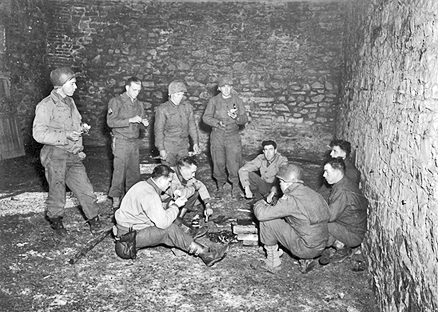 We kept warm with warm clothes…at night sometimes we were in camps, but usually we could find a house or barn to sleep in. We carried sleeping bags. We were often out for mission for weeks, we would carry sleeping bags…always able to find a house or building…farmhouses, lots of empty homes…
We kept warm with warm clothes…at night sometimes we were in camps, but usually we could find a house or barn to sleep in. We carried sleeping bags. We were often out for mission for weeks, we would carry sleeping bags…always able to find a house or building…farmhouses, lots of empty homes…
We were one of the first units into Germany. We crossed the Remagen Bridge into Germany before it was blown up over the Rhine. Later Germans bombed it, but by then engineers had laid a Bailey-pontoon-bridge across the Rhine. We crossed that way…I recall it was a railroad bridge. We had a mission on other side. The mission was always the same, look for airfields…
Paris was open city...when we got to there – we had our HQ in Paris…We had a mission to south of Paris…I took the group to check out an airfield. We would hang a flag on the jeep so as to indicate we were not an enemy jeep. British planes saw us south of Paris and waved at us… We completed the mission, we were 15 to 20 km south of Paris…when we got into the city we were greeted with champagne, flowers, etc. We found out later that General Leclerc, head of French Resistance, was coming from the south, too. People thought we were an advancing force of General Leclerc. We didn’t stay in Paris long though.
Part of our company HQ was in Paris for a while…we moved on with troops… Just in back of the line of combat. Germany wasn’t any different from France. We saw a few German people, all were very quiet…we did liberate one town in France…we were the first Americans and they saw happy to see us…
We had no contact with the German people themselves…only contact with our own troops and the British. We ran across one British outfit once and spent the day…we stood guard for them in exchange for breakfast the next morning. At 4:00 the tea caddy came with the British. They did not use the same airfields, had their own. Ours were for supply. Bombers were in England, they never were in France or Germany. Fighter pilots were mostly in England. Very few fighter pilots on the continent… There were lots of C47s 2 engine planes and 2/1/2 ton trucks, backbone of army.
How long a mission lasted depended. The average mission was 2 to 3 days, then back to HQ. One mission was in Spa and Malmedy…that was in the Ardennes…we were sent to find an airfield. We were in Spa and Malmedy…couldn’t find a place…we went back to our outfit…the next day Germans broke through in Battle of Bulge…we were in Liege, Belgium when that came through.
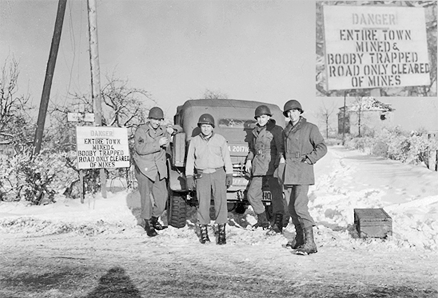 During the Battle of the Bulge we stayed in Liege…we were part of the fighting force if necessary… We waited stationed in Belgium…on standby duty until the Bulge ended…
During the Battle of the Bulge we stayed in Liege…we were part of the fighting force if necessary… We waited stationed in Belgium…on standby duty until the Bulge ended…
Our role was the same throughout war… We could have gone to Berlin but we were stopped at the Elbe to let Russians take it Berlin. May 8, 1945 at the Elbe got shipped back to Paris to await a boat to go home. We were alerted to go to Japan if necessary. While waiting we took over Chateau Biuk (?) in France.
People were sent home in a certain order…divisions were sent as units, then smaller units, there was a point system… you needed 70 points to get on a ship. I had 95 because of service ribbons medals etc…I got a ship to come back home – the Queen Mary… I went back to Fort Devens Massachusetts, then home in reserves five years as an officer. I was discharged later.
We knew nothing about the Holocaust, the whole time we never heard a thing, never saw a thing. Yet on one mission we ran across Nordhausen, a camp. We got there two days after the British liberated it. There were skeletons of people there…not even human in appearance…unreal...and this was only a work camp, not an extermination camp. People were being buried…people from the town were burying people…others were being taken away…June 10 to May 8, ‘45 in area…
I did bond with guys in my unit...we had reunions of the 922nd…every two to five years. I attended two. I keep in touch with three, Lieutenant Marzal, Captain Janoff, S-l officers and my driver John Marashack.
I remember one lucky incident. We were going along the road, the halftrack dropped a track and there was another right there nearby.
There was another incident with apples falling on the tent. I thought it was antiaircraft fire, spent shells.
We were part of the 9th Air Force…whatever they were doing that’s what we were to do.
We had K-rations, dried and canned food when on the mission. And two cigarettes in every K-ration… We heated the rations up on the jeep…
Lived in Hartford,
My wife was from Stamford, born and raised…I went into service from Hartford moved to Stamford 1948.
Photos Courtesy Nathan Norkin
United States Army Air Forces / Ninth Air Force
Overview of Air Force Combat Units of World War II
The Movement Toward Air Autonomy
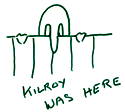 Introduction
Introduction
Veterans
Battles
Stamford Service Rolls
Homefront
Exhibit Photos
Opening Day

